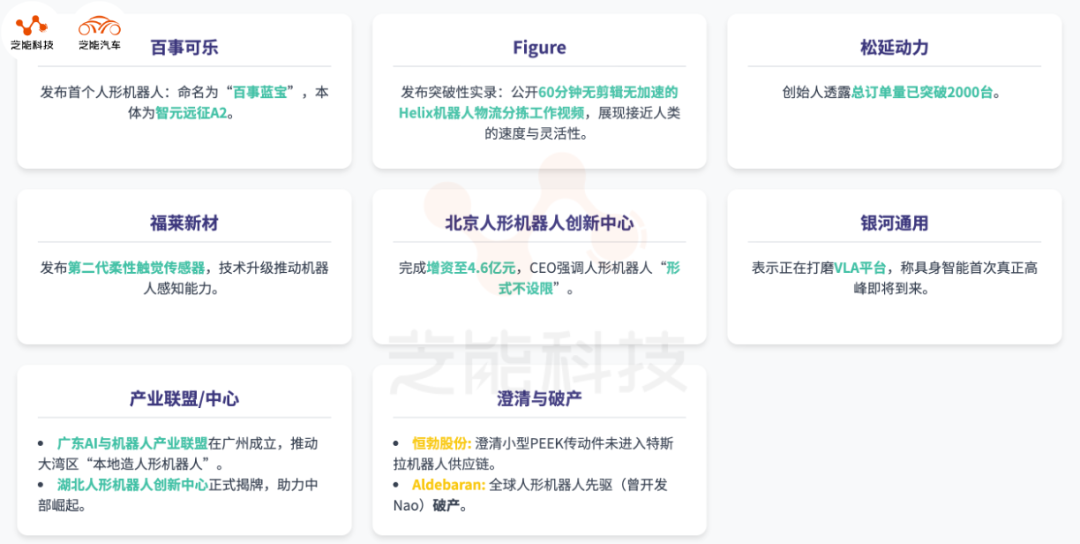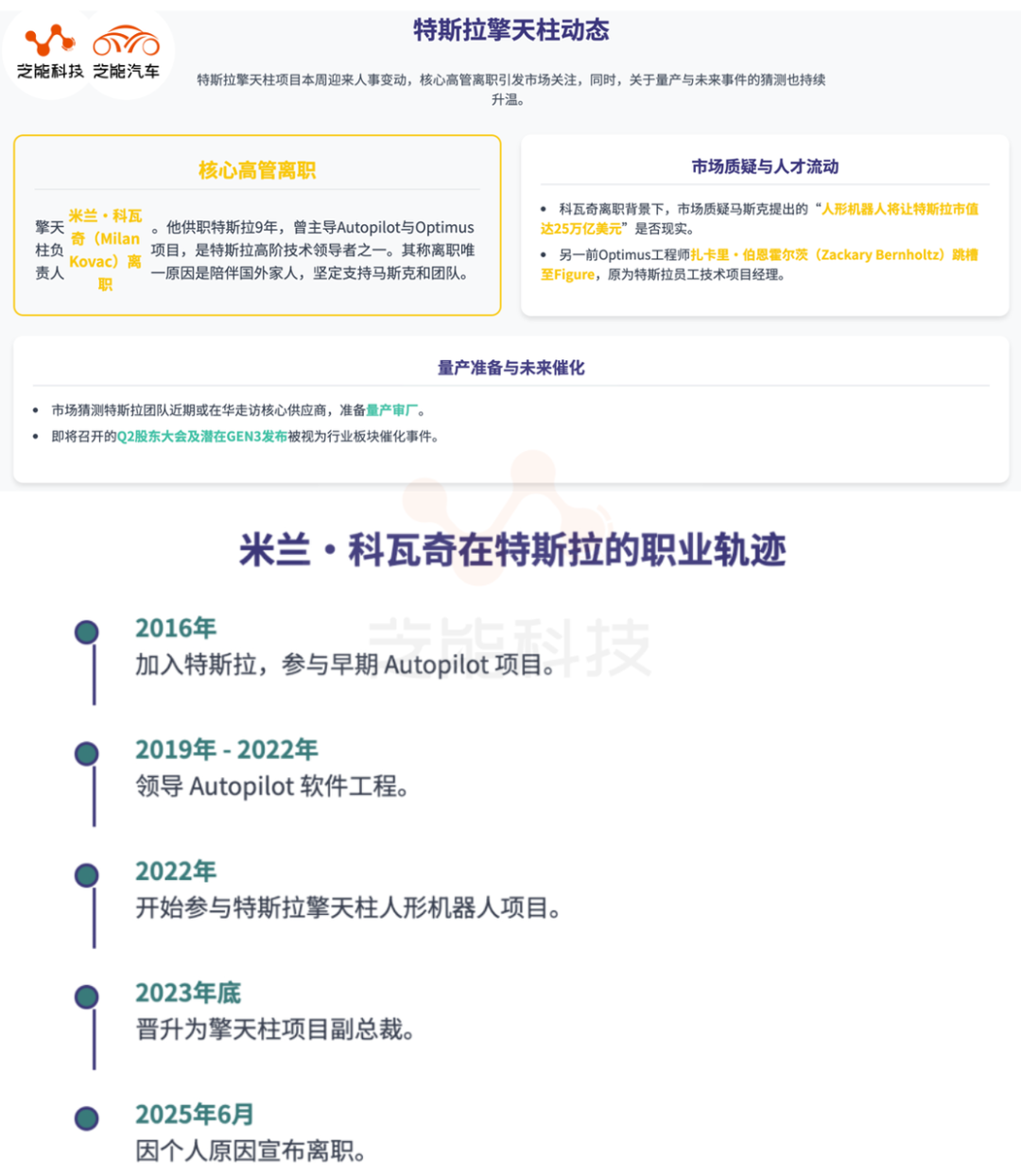Weekly Robot Industry Report | June 10: Industry Differentiation, Figure's Steady Progress, and Key Departure at Tesla
![]() 06/10 2025
06/10 2025
![]() 594
594
Produced by Zhineng Technology
Figure unveiled a 60-minute uncut logistics sorting demonstration video, pushing the technological envelope of the humanoid robot industry. Concurrently, Milan Kovac, a pivotal figure in Tesla's humanoid robot endeavor, announced his resignation, casting a cloud of uncertainty over Tesla's Optimus project.
Amid rapid advancements and significant personnel shifts, the industry is navigating a delicate adjustment period. This week's industry signals indicate that humanoid robots continue to advance, albeit on diverging paths.
01
Industry Weekly Trends:
Rising Temperatures, Continuous Technological Progress
This week, the humanoid robot industry maintained a high level of activity and diverse participation.
◎ PepsiCo launched its inaugural branded robot, 'Pepsi Blue Diamond,' leveraging the Zhiyuan Expedition A2 hardware, marking the brand's strategic foray into AI.
◎ Innovation hubs and industry alliances have emerged in Hubei, Beijing, Guangdong, and other regions, reflecting local governments' enthusiasm for policy support and resource consolidation in the humanoid robot sector.

◎ Figure stood out this week by releasing a 60-minute unedited logistics sorting video, showcasing its Helix robot's near-commercial operational capabilities, setting the industry benchmark.
In the video, the robot handled packages of varying sizes and shapes seamlessly, displaying near-human flexibility and recognition abilities. This marks a technological milestone for many manufacturers still in the experimental phase.
◎ Amazon is also experimenting with humanoid robots for package delivery, indicating that humanoid robots are penetrating the supply chain terminals of large platform companies, with scenario-based implementation no longer a distant dream.
◎ Amidst the industry's rapid growth, Aldebaran, an early pioneer in global humanoid robots, filed for bankruptcy. The company, known for the Nao robot, gradually fell behind in the new competitive landscape, ultimately exiting the stage.
Its demise serves as a reminder that amidst capital surges, sustained technological investment and scenario breakthroughs are crucial for navigating cyclical challenges.
Despite risks of local bubbles and over-promotion, the humanoid robot industry continues to solidify its foundations, transitioning from the 'showcasing phase' to the 'implementation phase,' evident from advancements in flexible tactile sensors, domestic power enterprises securing orders exceeding 2,000 units, and continuous policy support from various regions.
02
Executive Departure from Tesla's Robot Project
Its Profound Implications
As the industry presses forward, Tesla's humanoid robot project has witnessed a notable personnel change.
Milan Kovac, the head of the Optimus project, announced his resignation, citing the need for more family time abroad and emphasizing that his decision was unrelated to any internal company matters. Despite attempts to quell speculation, industry insiders continue to dissect the implications.

Kovac was instrumental in Tesla's autonomous driving team before taking the helm of the Optimus project, rapidly advancing it to a demonstrable stage.
Tesla CEO Elon Musk has publicly declared humanoid robots as Tesla's future 'core business,' projecting annual revenues of $10 trillion, potentially leading to a company market value of $25 trillion.
However, current industry assessments indicate that the actual valuation of the global humanoid robot market falls significantly short of these projections. Most institutions estimate the market size to be between $15 billion and $80 billion by 2032, a far cry from Musk's ambitious vision.
This disparity makes Kovac's resignation particularly sensitive. Some speculate that it might not solely be driven by 'personal reasons' but could reflect underlying concerns about project expectations, technical feasibility, and resource allocation.
Figure recently poached another Tesla humanoid robot engineer, Zachary Bernholtz, suggesting waning internal cohesion regarding the project.
While Tesla emphasizes the uniqueness of the Optimus project and has showcased its prototype capabilities, doubts persist about whether it relies on remote control during actual operations.
In contrast, companies like Figure, focused solely on humanoid robots with more agile organizations, are gradually consolidating technological leadership and brand influence. The current industry competition is poised to evolve into a technological showdown between Tesla and Figure, centered around real-world implementation in the coming years.
Moreover, Tesla has experienced a high talent turnover rate in recent years, particularly in key future-oriented areas like autonomous driving and robotics. The sustainability of its project continuity and innovation capabilities warrants close monitoring.
Summary
Amidst the apparent bustle of the humanoid robot industry, Tesla's key departure prompts a reevaluation of industry paths and commitments. This contrast underscores the industry's future development logic: technological delivery and sustained organizational stability are prerequisites for transitioning from hype to tangible productivity.
The humanoid robot industry is transitioning from 'high expectations' to 'actual delivery.' As the glitz fades, solutions that can genuinely integrate into real-world scenarios and gain acceptance from users and the industrial chain will ultimately define the value of this generation of robots.







